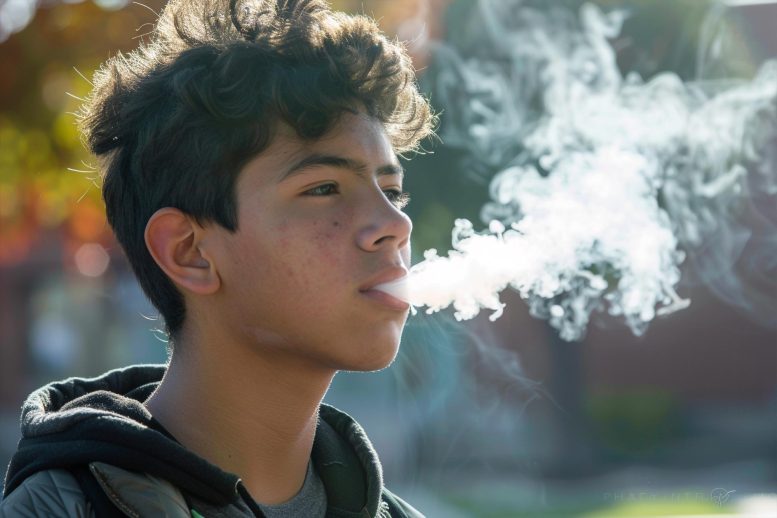
A study reveals that delta-8-THC, a psychoactive hemp derivative, is used by 11.4% of U.S. 12th graders, with higher rates in regions without specific regulations or legalized recreational marijuana. This underscores the need for regulatory measures to mitigate its public health risks, especially among youth. Credit: SciTechDaily.com
Researchers at the Keck School of Medicine of USC conducted one of the first nationally-representative studies of adolescent use of the new hemp-derived cannabis products, which have intoxicating effects that resemble marijuana.
A new study suggests that delta-8-THC, an intoxicating substance typically made from hemp, is being used by a substantial number of young people across the United States and could potentially pose a significant public health risk.
Delta-8-THC products, which include gummies and vapes, look like marijuana products and have similar mood-altering effects. Delta-8 is often manufactured out of cannabidiol from hemp rather than marijuana, and there is no federal minimum age requirement to purchase delta-8 products. In various states, delta-8-THC is widely sold at gas stations or online, but rates of use among American youth have been unknown.
Now, researchers from the Keck School of Medicine of USC, in collaboration with the University of Michigan and with support from the National Institute on Drug Abuse, have analyzed survey responses from more than 2,000 randomly selected U.S. 12th graders about their delta-8-THC use during 2023. Data came from students in the Monitoring the Future survey, the nation’s leading source for tracking drug use in American youth. The researchers found that 11.4% of 12th graders used delta-8-THC in the past year. Rates of delta-8-THC use were even higher in Southern and Midwestern states, as well as states that lacked their own delta-8-THC regulations or had not legalized adult (“recreational”) marijuana use. The results were just published in JAMA.
“Considering that delta-8-THC has only been on the market since 2018, the fact that we’re seeing more than 11% of youth using it is concerning,” said Alyssa F. Harlow, PhD, MPH, a clinical assistant professor in the department of population and public health sciences at the Keck School of Medicine, a member of the USC Institute for Addiction Science (USC IAS) and the study’s lead author. “It’s evidence that we should be paying attention to these products, particularly in the areas where we saw even higher prevalence.”
Because delta-8-THC is so new, its public health impact is unknown. Given the substance’s chemical similarities with delta-9-THC, the primary psychoactive component in marijuana, scientists are concerned that delta-8-THC could pose similar health risks to marijuana, including effects on brain development, addiction, behavioral problems and accidental overdose. Delta-8-THC is unregulated in many states, meaning there are few safeguards to prevent impurities and toxic compounds and no requirements for warning labels and ingredient listing. A lack of restrictions means that delta-8-THC can also be packaged and marketed in ways that appeal specifically to youth.
“Time and time again, we see the same pattern. When a new addictive drug hits the market and is commercialized, youth are the first to be affected if public health protections are not in place. We saw this with nicotine e-cigarettes and should not let history repeat itself with delta-8-THC or the other hemp products,” said the paper’s senior author, Adam Matthew Leventhal, PhD, a professor in the department of population and public health sciences at the Keck School of Medicine and executive director of USC IAS.
Nationwide Research and Public Health Concerns
The Keck School of Medicine team has been a driving force behind the public health research on delta-8-THC, sounding the alarm on its risks and leading efforts to study rates of use among youth.
“Until now, there were no studies that estimated how common delta-8-THC use is in a nationally representative sample,” Harlow said.
In 2023, 2,186 U.S. 12th graders who completed the Monitoring the Future survey answered questions about their delta-8-THC use. Monitoring the Future is a rigorous classroom-based survey that is considered a gold standard for tracking youth substance use. It includes students from every region of the country whose answers are weighted so that they accurately represent the gender, race and parental education levels of the U.S. population.
Of those surveyed, 11.4% of 12th graders reported using delta-8-THC in the past year and 30.4% reported using marijuana. Among those who had used delta-8-THC in the past year, 35.4% used it 10 or more times.
In Western states, 5% of youth used delta-8-THC, compared to 10.1% in Northeastern states, 14.3% in Southern states, and 14.6% in Midwestern states. In states where delta-8-THC was regulated, 5.7% of youth used the products, compared to 14.4% in states without regulations. Eight percent used delta-8-THC in states where adult marijuana use was legal, compared to 14% in states where adult marijuana use was banned.
Regulations to Reduce Risk
The findings provide early evidence that regulating delta-8-THC might help lower use among youth, Harlow said. While some states have completely banned the substance, restricting delta-8-THC products is also an option. Policies could include packaging and labeling requirements, a minimum purchasing age, restrictions on where delta-8-THC can be sold, or required testing of products for contaminants.
The present study was an initial pulse check on delta-8-THC use, but more research is needed. The 2024 Monitoring the Future survey will include additional questions on the new products, including what form youth are using (such as gummies, vape cartridges, or dried flower) and where they are purchasing it. Over time, longitudinal data will also help show which policy changes are effective for mitigating risk.
Harlow is also studying whether rules for delta-8-THC packaging—for example, the inclusion of cannabis warning labels—can change youth perceptions of how risky the products are.
Reference: “Adolescent Δ8-THC and Marijuana Use in the US” by Alyssa F. Harlow, Richard A. Miech and Adam M. Leventhal, 12 March 2024, JAMA.
DOI: 10.1001/jama.2024.0865
In addition to Harlow and Leventhal, the study’s other author is Richard Miech from the Institute for Social Research, University of Michigan.
This work is supported by the National Institute on Drug Abuse [K01DA058084, K24DA048160, R01DA001411]. The content is solely the responsibility of the authors and does not necessarily represent the official views of the National Institutes of Health.









Be the first to comment on "Unraveling the Delta-8 THC Trend Among American Teens"